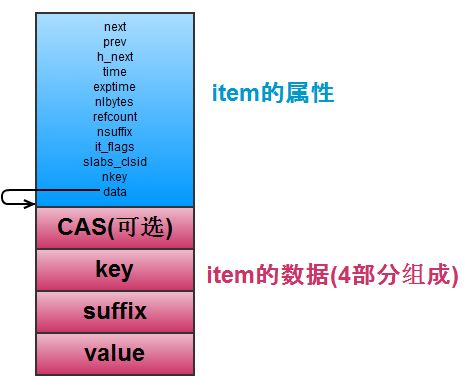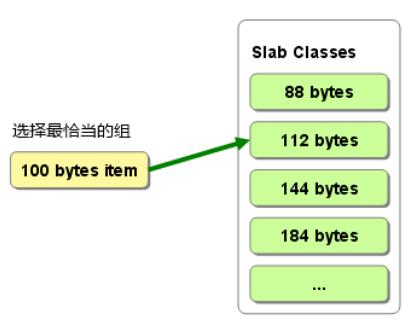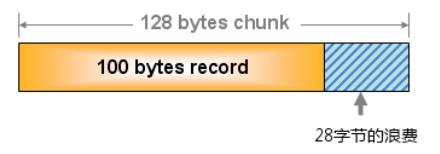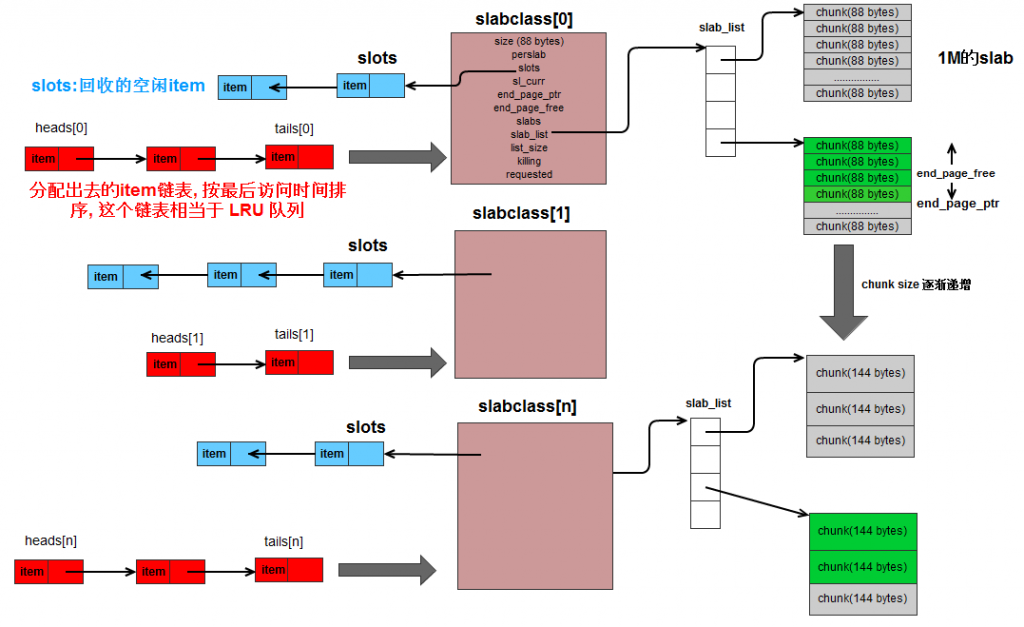memcache数据组织
转自:原链接
使用命令 set(key, value) 向 memcached 插入一条数据, memcached 内部是如何组织数据呢
一 把数据组装成 item
memcached 接受到客户端的数据后, 把数据组装成 item, item 的格式如下:

图1 struct item 的结构
CAS可选:cas的版本号
源码中这样定义 struct item:
- /**
- * Structure for storing items within memcached.
- */
- typedef struct _stritem {
- struct _stritem *next;
- struct _stritem *prev;
- struct _stritem *h_next; /* hash chain next */
- rel_time_t time; /* least recent access */
- rel_time_t exptime; /* expire time */
- int nbytes; /* size of data */
- unsigned short refcount;
- uint8_t nsuffix; /* length of flags-and-length string */
- uint8_t it_flags; /* ITEM_* above */
- uint8_t slabs_clsid;/* which slab class we're in */
- uint8_t nkey; /* key length, w/terminating null and padding */
- /* this odd type prevents type-punning issues when we do
- * the little shuffle to save space when not using CAS. */
- union {
- uint64_t cas;
- char end;
- } data[];
- /* if it_flags & ITEM_CAS we have 8 bytes CAS */
- /* then null-terminated key */
- /* then " flags length\r\n" (no terminating null) */
- /* then data with terminating \r\n (no terminating null; it's binary!) */
- } item;
从源码可以得出 item 的结构分两部分, 第一部分定义 item 结构的属性, 包括连接其它 item 的指针 (next, prev),
还有最近访问时间(time), 过期的时间(exptime), 以及数据部分的大小, 标志位, key的长度, 引用次数, 以及 item 是
从哪个 slabclass 分配而来.
item 结构体的定义使用了一个常用的技巧: 定义空数组 data, 用来指向 item 数据部分的首地址, 使用空数组的
好处是 data 指针本身不占用任何存储空间, 为 item 分配存储空间后, data 自然而然就指向数据部分的首地址.
第二部分是 item 的数据, 由 CAS, key, suffix, value 组成.
二 为 item 分配存储空间
把数据组装成 item 之前, 必须为 item 分配存储空间, memcached 不是直接从操作系统分配内存的, memcached
内部使用了类似内存池的东西, 即slab机制, 来管理内存. 内存的分配和回收都交给 slab 子系统实现. 所以我们先理解
slab, 再回过头来看如何为 item 分配存储空间.
三 使用 slab 管理内存
memcached 中, 内存的分配和回收, 都是通过 slab 实现的, slab机制相当于内存池机制, 实现从操作系统分配一大块
内存, 然后 memcached 自己管理这块内存, 负责分配与回收. 接下来我们详细剖析 slab 机制.
3.1 关于 slabclass
像一般的内存池一样, 从操作系统分配到一大块内存后, 为了方便管理, 把这大块内存划分为各种大小的 chunk,
chunk的大小按照一定比例逐渐递增, 如下图所示:

图2: 各个 slabclass 的 chunk size 按比例递增
从 slab 分配内存的时候, 根据请求内存块的大小, 找到大小最合适的 chunk 所在的 slabclass, 然后从这个
slabclass 找空闲的 chunk 分配出去. 所谓最合适就是指 chunk 的大小能够满足要求, 而且碎片最小.
如下图所示:

图3 寻找最合适的 slabclass
这种分配方式的缺点是存在内存碎片, 例如, 将 100字节的 item 存储到一个 128 字节的 chunk, 就有 28 字节
的内存浪费, 如下图所示:

图5 内存碎片
3.2 slabclass 的内部实现
slabclass 是由 chunk size 确定的, 同一个 slabclass 内的 chunk 大小都一样, 每一个 slabclass 要负责管理
一些内存, 初始时, 系统为每个 slabclass 分配一个 slab, 一个 slab 就是一个内存块, 其大小等于 1M. 然后每个
slabclass 再把 slab 切分成一个个 chunk, 算一下, 一个 slab 可以切分得到 1M/chunk_size 个chunk.
先来看一下源码中 slabclass 的定义:
- typedef struct {
- unsigned int size; /* sizes of items */
- unsigned int perslab; /* how many items per slab */
- void *slots; /* list of item ptrs */
- unsigned int sl_curr; /* total free items in list */
- void *end_page_ptr; /* pointer to next free item at end of page, or 0 */
- unsigned int end_page_free; /* number of items remaining at end of last alloced page */
- unsigned int slabs; /* how many slabs were allocated for this class */
- void **slab_list; /* array of slab pointers */
- unsigned int list_size; /* size of prev array */
- unsigned int killing; /* index+1 of dying slab, or zero if none */
- size_t requested; /* The number of requested bytes */
- } slabclass_t;
slabclass 的结构图如下所示:

图6 slabclass 结构图
结合 slabclass 的结构图, 我们说明一下 slabclass 结构体的各个属性:
(1) size 和 perslab
size 定义该 slabclass 的 chunk 大小, perslab 表示每个 slab 可以切分成多少个 chunk, 如果一个 slab 等于
1M, 那么就有 perslab = 1M / size
(2) slots 和 sl_curr
slots 是回收的 item 链表, 从某个 slabclass 分配出去一个 item, 当 item 回收的时候,
不是把这 item 使用的内存交还给 slab, 而是让这个 item 挂在 slots 链表的尾部. sl_curr 表示当前链表中
有多少个回收而来的空闲 item.
(3) slab_list 和 list_size
前面说过, 初始时, memcached 为每个 slabclass 分配一个 slab, 当这个 slab 内存块使用完后, memcached
就分配一个新的 slab, 所以 slabclass 可以拥有多个 slab, 这些 slab 就是通过 slab_list 数组来管理的, list_size
表示当前 slabclass 有多少个 slab.
(4) end_page_ptr 和 end_page_free
在 subclass 内, 只有最后一个 slab 存在空闲的内存, 其它 slab 的 chunk 都分配出去了, end_page_ptr
指向最后一个 slab 中的空闲内存块, end_page_free 表示最后一个 slab 中还剩下多少个空闲 chunk. 图6
中绿色部分的 chunk 表示空闲 chunk
(5) static item *heads[LARGEST_ID];
static item *tails[LARGEST_ID];
当 memcached 没有足够的内存使用时, 必须选择性地回收一些 item, 回收采用 LRU 算法, 这就需要维护
一个按照最近访问时间排序的 LRU 队列. 在 memcached 中,
每个 slabclass 维护一个链表, 比如 slabclass[i] 的链表头指针为 heads[i], 尾指针为 tails[i],
已分配出去的 item 都存储在链表中. 而且链表中 item 按照最近访问时间排序, 这样一些链表相当于
LRU 队列.
四 源码分析
4.1 do_slabs_newslab
前面说过每个 slabclass 都拥有一些 slab, 当所有 slab 都用完时, memcached 会给它分配一个新的 slab,
do_slabs_newslab 就是做这个工作的.
- static int do_slabs_newslab(const unsigned int id) {
- slabclass_t *p = &slabclass[id];
- int len = settings.slab_reassign ? settings.item_size_max
- : p->size * p->perslab;
- char *ptr;
- if ((mem_limit && mem_malloced + len > mem_limit && p->slabs > 0) ||
- (grow_slab_list(id) == 0) ||
- ((ptr = memory_allocate((size_t)len)) == 0)) {
- MEMCACHED_SLABS_SLABCLASS_ALLOCATE_FAILED(id);
- return 0;
- }
- memset(ptr, 0, (size_t)len);
- p->end_page_ptr = ptr;
- p->end_page_free = p->perslab;
- p->slab_list[p->slabs++] = ptr;
- mem_malloced += len;
- MEMCACHED_SLABS_SLABCLASS_ALLOCATE(id);
- return 1;
- }
分配一个新的 slab, 必须把该 slab 的首地址安插在 slab_list 数组中, 所以先调用 grow_slab_list 来确保 slab_list
数组有足够的容量, 如果容量不足, grow_slab_list 会对 slab_list 扩容.
然后调用 memory_allocate 分配 1M 的内存空间, memory_allocate 从预先分配的内存取下 1M 大小的
空闲内存块,作为新的 slab.
最后调整 end_page_ptr, 新分配的 slab 全部都是空闲内存块, 所以 end_page_ptr 指向新 slab 的首地址.
这个新 slab 的首地址也被安插在 slab_list 数组中.
4.2 do_slabs_alloc
这个函数从指定的 slabclass, 即 slabclass[id], 分配大小为 size 的内存块供申请者使用.
分配的原则是, 优先从 slots 指向的空闲链表中分配, 空闲链表没有, 才从 slab 中分配一个空闲的 chunk.
- static void *do_slabs_alloc(const size_t size, unsigned int id) {
- slabclass_t *p;
- void *ret = NULL;
- item *it = NULL;
- if (id < POWER_SMALLEST || id > power_largest) {
- MEMCACHED_SLABS_ALLOCATE_FAILED(size, 0);
- return NULL;
- }
- p = &slabclass[id];
- assert(p->sl_curr == 0 || ((item *)p->slots)->slabs_clsid == 0);
- /* 如果不使用 slab 机制, 则直接从操作系统分配 */
- #ifdef USE_SYSTEM_MALLOC
- if (mem_limit && mem_malloced + size > mem_limit) {
- MEMCACHED_SLABS_ALLOCATE_FAILED(size, id);
- return 0;
- }
- mem_malloced += size;
- ret = malloc(size);
- MEMCACHED_SLABS_ALLOCATE(size, id, 0, ret);
- return ret;
- #endif
- /* fail unless we have space at the end of a recently allocated page,
- we have something on our freelist, or we could allocate a new page */
- /* 确保最后一个slab 有空闲的chunk */
- if (! (p->end_page_ptr != 0 || p->sl_curr != 0 ||
- do_slabs_newslab(id) != 0)) {
- /* We don't have more memory available */
- ret = NULL;
- } else if (p->sl_curr != 0) {
- /* 从空闲list分配一个item */
- /* return off our freelist */
- it = (item *)p->slots;
- p->slots = it->next;
- if (it->next) it->next->prev = 0;
- p->sl_curr--;
- ret = (void *)it;
- } else {
- /* 从最后一个slab中分配一个空闲chunk */
- /* if we recently allocated a whole page, return from that */
- assert(p->end_page_ptr != NULL);
- ret = p->end_page_ptr;
- if (--p->end_page_free != 0) {
- p->end_page_ptr = ((caddr_t)p->end_page_ptr) + p->size;
- } else {
- p->end_page_ptr = 0;
- }
- }
- if (ret) {
- p->requested += size;
- MEMCACHED_SLABS_ALLOCATE(size, id, p->size, ret);
- } else {
- MEMCACHED_SLABS_ALLOCATE_FAILED(size, id);
- }
- return ret;
- }
4.3 do_slabs_free
把 ptr 指向的 item 归还给 slabclass[id]
操作很简单, 把 ptr 指向的 item 挂在 slots 空闲链表的最前面
- static void do_slabs_free(void *ptr, const size_t size, unsigned int id) {
- slabclass_t *p;
- item *it;
- assert(((item *)ptr)->slabs_clsid == 0);
- assert(id >= POWER_SMALLEST && id <= power_largest);
- if (id < POWER_SMALLEST || id > power_largest)
- return;
- MEMCACHED_SLABS_FREE(size, id, ptr);
- p = &slabclass[id];
- #ifdef USE_SYSTEM_MALLOC
- mem_malloced -= size;
- free(ptr);
- return;
- #endif
- /* 把 item 归还给slots指向的空闲链表, 插在链表的最前面 */
- it = (item *)ptr;
- it->it_flags |= ITEM_SLABBED;
- it->prev = 0;
- it->next = p->slots;
- if (it->next) it->next->prev = it;
- p->slots = it;
- p->sl_curr++;
- p->requested -= size;
- return;
- }
4.4 do_item_alloc
从 slab 系统分配一个空闲 item
- item *do_item_alloc(char *key, const size_t nkey, const int flags, const rel_time_t exptime, const int nbytes) {
- uint8_t nsuffix;
- item *it = NULL;
- char suffix[40];
- size_t ntotal = item_make_header(nkey + 1, flags, nbytes, suffix, &nsuffix);
- if (settings.use_cas) {
- ntotal += sizeof(uint64_t);
- }
- unsigned int id = slabs_clsid(ntotal);
- if (id == 0)
- return 0;
- mutex_lock(&cache_lock);
- /* do a quick check if we have any expired items in the tail.. */
- item *search;
- rel_time_t oldest_live = settings.oldest_live;
- search = tails[id];
- if (search != NULL && (refcount_incr(&search->refcount) == 2)) {
- /* 先检查 LRU 队列最后一个 item 是否超时, 超时的话就把这个 item 分配给用户 */
- if ((search->exptime != 0 && search->exptime < current_time)
- || (search->time <= oldest_live && oldest_live <= current_time)) { // dead by flush
- STATS_LOCK();
- stats.reclaimed++;
- STATS_UNLOCK();
- itemstats[id].reclaimed++;
- if ((search->it_flags & ITEM_FETCHED) == 0) {
- STATS_LOCK();
- stats.expired_unfetched++;
- STATS_UNLOCK();
- itemstats[id].expired_unfetched++;
- }
- it = search;
- slabs_adjust_mem_requested(it->slabs_clsid, ITEM_ntotal(it), ntotal);
- /* 把这个 item 从 LRU 队列和哈希表中移除 */
- do_item_unlink_nolock(it, hash(ITEM_key(it), it->nkey, 0));
- /* Initialize the item block: */
- it->slabs_clsid = 0;
- /* 没有超时的 item, 那就尝试从 slabclass 分配, 运气不好的话, 分配失败,
- 那就把 LRU 队列最后一个 item 剔除, 然后分配给用户 */
- } else if ((it = slabs_alloc(ntotal, id)) == NULL) {
- if (settings.evict_to_free == 0) {
- itemstats[id].outofmemory++;
- pthread_mutex_unlock(&cache_lock);
- return NULL;
- }
- itemstats[id].evicted++;
- itemstats[id].evicted_time = current_time - search->time;
- if (search->exptime != 0)
- itemstats[id].evicted_nonzero++;
- if ((search->it_flags & ITEM_FETCHED) == 0) {
- STATS_LOCK();
- stats.evicted_unfetched++;
- STATS_UNLOCK();
- itemstats[id].evicted_unfetched++;
- }
- STATS_LOCK();
- stats.evictions++;
- STATS_UNLOCK();
- it = search;
- slabs_adjust_mem_requested(it->slabs_clsid, ITEM_ntotal(it), ntotal);
- /* 把这个 item 从 LRU 队列和哈希表中移除 */
- do_item_unlink_nolock(it, hash(ITEM_key(it), it->nkey, 0));
- /* Initialize the item block: */
- it->slabs_clsid = 0;
- } else {
- refcount_decr(&search->refcount);
- }
- /* LRU 队列是空的, 或者锁住了, 那就只能从 slabclass 分配内存 */
- } else {
- /* If the LRU is empty or locked, attempt to allocate memory */
- it = slabs_alloc(ntotal, id);
- if (search != NULL)
- refcount_decr(&search->refcount);
- }
- if (it == NULL) {
- itemstats[id].outofmemory++;
- /* Last ditch effort. There was a very rare bug which caused
- * refcount leaks. We leave this just in case they ever happen again.
- * We can reasonably assume no item can stay locked for more than
- * three hours, so if we find one in the tail which is that old,
- * free it anyway.
- */
- if (search != NULL &&
- search->refcount != 2 &&
- search->time + TAIL_REPAIR_TIME < current_time) {
- itemstats[id].tailrepairs++;
- search->refcount = 1;
- do_item_unlink_nolock(search, hash(ITEM_key(search), search->nkey, 0));
- }
- pthread_mutex_unlock(&cache_lock);
- return NULL;
- }
- assert(it->slabs_clsid == 0);
- assert(it != heads[id]);
- /* 顺便对 item 做一些初始化 */
- /* Item initialization can happen outside of the lock; the item's already
- * been removed from the slab LRU.
- */
- it->refcount = 1; /* the caller will have a reference */
- pthread_mutex_unlock(&cache_lock);
- it->next = it->prev = it->h_next = 0;
- it->slabs_clsid = id;
- DEBUG_REFCNT(it, '*');
- it->it_flags = settings.use_cas ? ITEM_CAS : 0;
- it->nkey = nkey;
- it->nbytes = nbytes;
- memcpy(ITEM_key(it), key, nkey);
- it->exptime = exptime;
- memcpy(ITEM_suffix(it), suffix, (size_t)nsuffix);
- it->nsuffix = nsuffix;
- return it;
- }
4.5 do_item_link
形成了一个完成的 item 后, 就要把它放入两个数据结构中, 一是 memcached 的哈希表,
memcached 运行过程中只有一个哈希表, 二是 item 所在的 slabclass 的 LRU 队列.
如 图6 所示, 每个 slabclass 都有一个 LRU 队列
- int do_item_link(item *it, const uint32_t hv) {
- MEMCACHED_ITEM_LINK(ITEM_key(it), it->nkey, it->nbytes);
- assert((it->it_flags & (ITEM_LINKED|ITEM_SLABBED)) == 0);
- mutex_lock(&cache_lock);
- it->it_flags |= ITEM_LINKED;
- it->time = current_time;
- STATS_LOCK();
- stats.curr_bytes += ITEM_ntotal(it);
- stats.curr_items += 1;
- stats.total_items += 1;
- STATS_UNLOCK();
- /* Allocate a new CAS ID on link. */
- ITEM_set_cas(it, (settings.use_cas) ? get_cas_id() : 0);
- /* 把 item 放入哈希表 */
- assoc_insert(it, hv);
- /* 把 item 放入 LRU 队列*/
- item_link_q(it);
- refcount_incr(&it->refcount);
- pthread_mutex_unlock(&cache_lock);
- return 1;
- }
4.6 do_item_unlink
do_item_unlink 与 do_item_unlink 做的工作相反, 把 item 从哈希表和 LRU 队列中删除,
而且还释放掉 item 所占的内存 (其实只是把 item 放到空闲链表中).
- void do_item_unlink(item *it, const uint32_t hv) {
- MEMCACHED_ITEM_UNLINK(ITEM_key(it), it->nkey, it->nbytes);
- mutex_lock(&cache_lock);
- if ((it->it_flags & ITEM_LINKED) != 0) {
- it->it_flags &= ~ITEM_LINKED;
- STATS_LOCK();
- stats.curr_bytes -= ITEM_ntotal(it);
- stats.curr_items -= 1;
- STATS_UNLOCK();
- /* 从哈希表中删除 item */
- assoc_delete(ITEM_key(it), it->nkey, hv);
- /* 从 LRU 队列中删除 item */
- item_unlink_q(it);
- /* 释放 item 所占的内存 */
- do_item_remove(it);
- }
- pthread_mutex_unlock(&cache_lock);
- }
4.7 item_get
根据 key 找对应的 item, 为了加快查找速度, memcached 使用一个哈希表对 key 和 item 所在的内存
地址做映射. item_get 直接从哈希表中查找就可以了, 当然找到了还要检查 item 是否超时. 超时了的 item
将从哈希表和 LRU 队列中删除掉
- /** wrapper around assoc_find which does the lazy expiration logic */
- item *do_item_get(const char *key, const size_t nkey, const uint32_t hv) {
- mutex_lock(&cache_lock);
- /* 从哈希表中找 item */
- item *it = assoc_find(key, nkey, hv);
- if (it != NULL) {
- refcount_incr(&it->refcount);
- /* Optimization for slab reassignment. prevents popular items from
- * jamming in busy wait. Can only do this here to satisfy lock order
- * of item_lock, cache_lock, slabs_lock. */
- if (slab_rebalance_signal &&
- ((void *)it >= slab_rebal.slab_start && (void *)it < slab_rebal.slab_end)) {
- do_item_unlink_nolock(it, hv);
- do_item_remove(it);
- it = NULL;
- }
- }
- pthread_mutex_unlock(&cache_lock);
- int was_found = 0;
- if (settings.verbose > 2) {
- if (it == NULL) {
- fprintf(stderr, "> NOT FOUND %s", key);
- } else {
- fprintf(stderr, "> FOUND KEY %s", ITEM_key(it));
- was_found++;
- }
- }
- /* 找到了, 然后检查是否超时 */
- if (it != NULL) {
- if (settings.oldest_live != 0 && settings.oldest_live <= current_time &&
- it->time <= settings.oldest_live) {
- do_item_unlink(it, hv);
- do_item_remove(it);
- it = NULL;
- if (was_found) {
- fprintf(stderr, " -nuked by flush");
- }
- } else if (it->exptime != 0 && it->exptime <= current_time) {
- do_item_unlink(it, hv);
- do_item_remove(it);
- it = NULL;
- if (was_found) {
- fprintf(stderr, " -nuked by expire");
- }
- } else {
- it->it_flags |= ITEM_FETCHED;
- DEBUG_REFCNT(it, '+');
- }
- }
- if (settings.verbose > 2)
- fprintf(stderr, "\n");
- return it;
- }
memcache数据组织的更多相关文章
- RDBMS,memcache
1.RDBMS即关系数据库管理系统(Relational Database Management System),是将数据组织为相关的行和列的系统,而管理关系数据库的计算机软件就是关系数据库管理系统, ...
- NoSQL分类及ehcache memcache redis 三大缓存的对比
NoSQL分类 由于NoSQL中没有像传统数据库那样定义数据的组织方式为关系型的,所以只要内部的数据组织采用了非关系型的方式,就可以称之为NoSQL数据库.目前,可以将众多的NoSQL数据库按照内部的 ...
- PHP之Memcache缓存详解
Mem:memory缩写(内存):内存缓存 1. 断电或者重启服务器内存数据即消失,即临时数据: Memcache默认端口:11211 存入方式:key=>>value ...
- 走进缓存的世界(三) - Memcache
系列文章 走进缓存的世界(一) - 开篇 走进缓存的世界(二) - 缓存设计 走进缓存的世界(三) - Memcache 简介 Memcache是一个高性能的分布式内存对象缓存系统,用于动态Web应用 ...
- 网站缓存技术总结( ehcache、memcache、redis对比)
网站技术高速发展的今天,缓存技术已经成为大型网站的一个关键技术,缓存设计好坏直接关系的一个网站访问的速度,以及购置服务器的数量,甚至影响到用户的体验. 网站缓存按照存放的地点不同,可以分为客户端缓存. ...
- MemCache超详细解读
MemCache是什么 MemCache是一个自由.源码开放.高性能.分布式的分布式内存对象缓存系统,用于动态Web应用以减轻数据库的负载.它通过在内存中缓存数据和对象来减少读取数据库的次数,从而提高 ...
- 如何在腾讯开放平台的云服务器上安装php和memcache 一
由于被通知腾讯的CEE要关闭了,必须自己切换到服务器,自己装php.烦到一个B. 首先找到官方wiki: http://wiki.qcloud.com/wiki/SUSE%E7%8E%AF%E5%A2 ...
- 搭建LNAMP环境(七)- PHP7源码安装Memcached和Memcache拓展
上一篇:搭建LNAMP环境(六)- PHP7源码安装MongoDB和MongoDB拓展 一.安装Memcached 1.yum安装libevent事件触发管理器 yum -y install libe ...
- 前端学PHP之PHP操作memcache
× 目录 [1]安装 [2]连接 [3]增删改查[4]分布式[5]状态[6]安全[7]应用 前面的话 和访问mysql服务器类似,PHP也是作为客户端API访问memcached服务器的,所以同样需要 ...
随机推荐
- PHP全选择删除功能
<script type="text/javascript" language="javascript"> function selectBox(s ...
- merge 语句的语法
/*Merge into 详细介绍 MERGE语句是Oracle9i新增的语法,用来合并UPDATE和INSERT语句. 通过MERGE语句,根据一张表或子查询的连接条件对另外一张表进行查询, 连接条 ...
- 转载 Deep learning:五(regularized线性回归练习)
前言: 本节主要是练习regularization项的使用原则.因为在机器学习的一些模型中,如果模型的参数太多,而训练样本又太少的话,这样训练出来的模型很容易产生过拟合现象.因此在模型的损失函数中,需 ...
- Android中的分页加载
//----------------------MainActivity中--------------------------------------------------- package com ...
- GameUnity 2.0 文档(三) 纸片人八方向
DirectSprite类 有别于 上篇文档出现的 AnimationSprite类 (从头播放到尾) 这个类根据 path的图,如果是 8*8 64个图 八方向,可以设置长宽和 角度 角度 代表 8 ...
- HDU - 1702 ACboy needs your help again!(栈和队列)
Description ACboy was kidnapped!! he miss his mother very much and is very scare now.You can't image ...
- HDU - 1083 Courses /POJ - 1469
题目链接:http://acm.hdu.edu.cn/showproblem.php?pid=1083 http://poj.org/problem?id=1469 题意:给你P个课程,并且给出每个课 ...
- UVALive 6885 Flowery Trails
两次SPFA #include<cstdio> #include<cstring> #include<cmath> #include<vector> # ...
- select 通过表单提交获取select中的值
<select class="txt" name="choice"> <option value="name" ...
- 使用nodejs的http模块创建web服务器
使用nodejs的http模块创建web服务器 laiqun@msn.cn Contents 1. web服务器基础知识 2. Node.js的Web 服务器 3. 代码实现 1. web服务器基础知 ...
